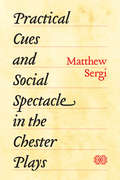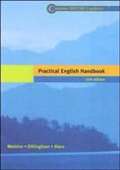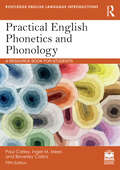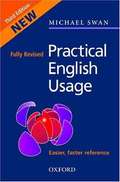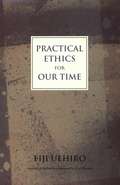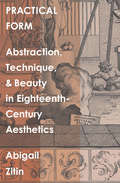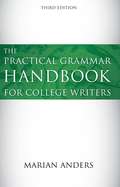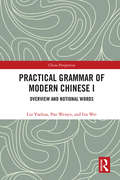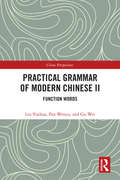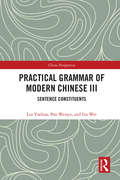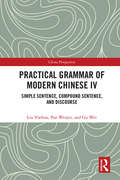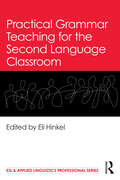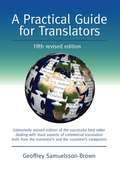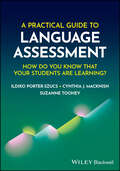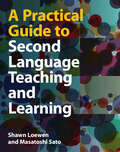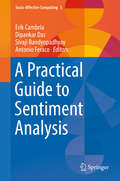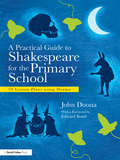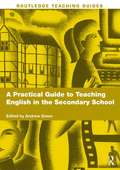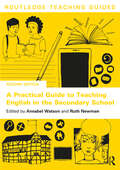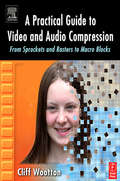- Table View
- List View
Practical Cues and Social Spectacle in the Chester Plays
by Matthew SergiAmid the crowded streets of Chester, guild players portraying biblical characters performed on colorful mobile stages hoping to draw the attention of fellow townspeople. In the fifteenth and sixteenth centuries, these Chester plays employed flamboyant live performance to adapt biblical narratives. But the original format of these fascinating performances remains cloudy, as surviving records of these plays are sparse, and the manuscripts were only written down a generation after they stopped. Revealing a vibrant set of social practices encoded in the Chester plays, Matthew Sergi provides a new methodology for reading them and a transformative look at medieval English drama. Carefully combing through the plays, Sergi seeks out cues in the dialogues that reveal information about the original staging, design, and acting. These “practical cues,” as he calls them, have gone largely unnoticed by drama scholars, who have focused on the ideology and historical contexts of these plays, rather than the methods, mechanics, and structures of the actual performances. Drawing on his experience as an actor and director, he combines close readings of these texts with fragments of records, revealing a new way to understand how the Chester plays brought biblical narratives to spectators in the noisy streets. For Sergi, plays that once appeared only as dry religious dramas come to life as raucous participatory spectacles filled with humor, camp, and devotion.
Practical English Handbook, Eleventh Edition
by Floyd C. Watkins William B. Dillingham John HiersThe Practical English Handbook includes concise explanations, abundant examples and models, ample practice opportunity, and help with all stages of the writing process. A coding system breaks down topics and facilitates student use. The MLA and APA documentation guidelines thoroughly reflect the most recent changes.
Practical English Phonetics and Phonology: A Resource Book for Students (Routledge English Language Introductions)
by Paul Carley Inger M. Mees Beverley CollinsRoutledge English Language Introductions cover core areas of language study and are one-stop resources for students. Assuming no prior knowledge, books in the series offer an accessible overview of the subject, with activities, study questions, sample analyses and commentaries.Revised and updated throughout, this fifth edition of Practical English Phonetics and Phonology: treats British and American English side by side throughout the book, which is new to this edition; presents the essentials of the subject and their day-to-day applications in an engaging and accessible manner; covers all the core concepts of phonetics and phonology, such as the phoneme, syllable structure, production of speech, vowel and consonant possibilities, glottal settings, stress, weak forms, rhythm, intonation and the surprises of connected speech; gives descriptions of the sound systems of Spanish, Italian, French, German, Polish and Japanese; includes a glossary of key terms and new exercises, diagrams and updated references; is accompanied by an updated companion website which hosts a collection of samples provided by genuine speakers of 25 accent varieties from Britain, Ireland, the USA, Canada, Australia, New Zealand, South Africa, India, Singapore and West Africa, as well as answer keys and numerous recordings to accompany activities in the book. Written by authors who are experienced teachers and researchers, this bestselling textbook will appeal to all students of English language and linguistics and those training for a certificate in TEFL.
Practical English Phonetics and Phonology: A Resource Book for Students (Routledge English Language Introductions)
by Beverley Collins Inger M. Mees Paul CarleyRoutledge English Language Introductions cover core areas of language study and are one-stop resources for students. Assuming no prior knowledge, books in the series offer an accessible overview of the subject, with activities, study questions, sample analyses, commentaries and key readings – all in the same volume. The innovative and flexible ‘two-dimensional’ structure is built around four sections – Introduction, Development, Exploration and Extension – which offer self-contained stages for study. Revised and updated throughout, this fourth edition of Practical English Phonetics and Phonology: presents the essentials of the subject and their day-to-day applications in an engaging and accessible manner; covers all the core concepts of phonetics and phonology, such as the phoneme, syllable structure, production of speech, vowel and consonant possibilities, glottal settings, stress, rhythm, intonation and the surprises of connected speech; incorporates classic readings from key names in the discipline; outlines the sound systems of six key languages from around the world (Spanish, French, Italian, German, Polish and Japanese); is accompanied by a brand-new companion website which hosts a collection of samples provided by genuine speakers of 25 accent varieties from Britain, Ireland, the USA, Canada, Australia, New Zealand, South Africa, India, Singapore and West Africa, as well as transcriptions, further study questions, answer keys, links to further reading and numerous recordings to accompany activities in the book. This edition has been completely reorganised and new features include: updated descriptions of the sounds of modern English and the adoption of the term General British (GB); considerable expansion of the treatment of intonation, including new recordings; and two new readings by David Crystal and John Wells. Written by authors who are experienced teachers and researchers, this best-selling textbook will appeal to all students of English language and linguistics and those training for a certificate in TEFL.
Practical English Usage
by Michael SwanThis unique reference guide addresses problem points in the language as encountered by learners and their teachers. It gives information and advice that is practical, clear, reliable, and easy to find. Most of the book is about grammar, but it also covers selected points of vocabulary, idioms, style, pronunciation, and spelling.
Practical Ethics for Our Time
by Carl Becker Eiji UehiroA scathing critique of the global consumer culture that's bound to cause controversy among Western readers, Practical Ethics for Our Time argues that Japan's future success as a nation depends upon the ability of its citizens to uphold traditional family values and to fashion new, environmentally sustainable patterns in their daily lives.Mr. Uehiro's argument is not unfamiliar. He posits that Japan's rapid industrialization and Westernization since the Meiji Restoration has created a nation of people with an insatiable appet ite for designer clothing, luxury cars, and high-tech gadgets but with a profound sense of spiritual emptiness. Uehiro suggests that as human be ings move farther and farther away from the process of producing goods themselves,they begin to take their abundance for granted, and thus lose a sense of thankfulness for what they have. This leads to a world in which human interactions become superficial and commodified, and ethics take a back seat to other, more quantifiable concerns. While Japan has gained tremendous international respect for its rapid industrialization since World War II , Uehiro believes that Japan has a greater role to play on the international stage as a model of proper ethical behavior- but only if it can reverse Western-influenced trends.
Practical Form: Abstraction, Technique, and Beauty in Eighteenth-Century Aesthetics (The Lewis Walpole Series in Eighteenth-Century Culture and History)
by Abigail ZitinA groundbreaking study of the development of form in eighteenth-century aesthetics In this original work, Abigail Zitin proposes a new history of the development of form as a concept in and for aesthetics. Her account substitutes women and artisans for the proverbial man of taste, asserting them as central figures in the rise of aesthetics as a field of philosophical inquiry in eighteenth-century Europe. She shows how the idea of formal abstraction so central to conceptions of beauty in this period emerges from the way practitioners think about craft and skill across the domestic, industrial, and so-called high arts. Zitin elegantly maps the complex connections among aesthetics, form, and formalism, drawing out the understated presence of practice in the writings of major eighteenth-century thinkers including Locke, Addison, Burke, and Kant. This new take on an old story ultimately challenges readers to reconsider form and why it matters.
The Practical Grammar Handbook for College Writers
by Marian AndersAppropriate for college composition classes, higher developmental courses, and upper-level high school classes, it provides a step-by-step curriculum that guides students to a thorough understanding of the structure of the English language. It can be used as a teaching textbook or as a reference book. The clear explanations allow students to read and understand the material on their own.
Practical Grammar of Modern Chinese I: Overview and Notional Words (Chinese Linguistics)
by Liu Yuehua Pan Wenyu Gu WeiChinese grammar is characterized by its simple structure, lack of inflections, and wide use of monosyllabic morphemes. With the increased popularity of learning Chinese as a second language, there is a demand for a guide to Chinese grammar that's targeted at second language learners. This four-volume set is one of the earliest and most influential works of Chinese grammar, with a special focus on teaching and learning Chinese as a second language. Drawing on rich teaching experience, the authors analyze a myriad of real-world examples to describe Chinese grammatical phenomena and rules while introducing the general grammar system of Chinese. In addition, the use of notional words in modern Chinese grammar is demonstrated, including nouns, pronouns, numerals, quantifiers, verbs, adjectives, and adverbs. Since the first edition came out in 1983, this set has been revised twice and has remained one of the best sellers in the field. Practitioners and scholars of teaching Chinese as a second language, as well as students with a basic knowledge of Chinese, will find it to be a handy reference.
Practical Grammar of Modern Chinese II: Function Words (Chinese Linguistics)
by Liu Yuehua Pan Wenyu Gu WeiChinese grammar is characterized by its simple structure, lack of inflections, and wide use of monosyllabic morphemes. With the increasing popularity of learning Chinese as a second language, there is a demand for a guide to Chinese grammar that's targeted at second language learners. This four-volume set is one of the earliest and most influential works on Chinese grammar, with a special focus on teaching and learning Chinese as a second language. Utilizing their rich teaching experience, the authors analyze a myriad of authentic examples to describe the Chinese grammatical phenomenon and rules. This volume introduces the functional words in modern Chinese grammar, which include prepositions, conjunctions, auxiliary verbs, onomatopoeia, and interjections. Since the first edition came out in 1983, this set has been revised twice and remained one of the best sellers in this topic. Practitioners and scholars of teaching Chinese as a second language, as well as students with a basic knowledge of Chinese, will find it a handy reference.
Practical Grammar of Modern Chinese III: Sentence Constituents (Chinese Linguistics)
by Liu Yuehua Pan Wenyu Gu WeiChinese grammar is characterized by its simple structure, lack of inflections, and wide use of monosyllabic morphemes. With the increased popularity of learning Chinese as a second language, there is a demand for a guide to Chinese grammar that's targeted at second language learners. This four-volume set is one of the earliest and most influential works of Chinese grammar, with a special focus on teaching and learning Chinese as a second language. Drawing on rich teaching experience, the authors analyze a myriad of real world examples to describe Chinese grammatical phenomena and rules while introducing the general grammar system of Chinese. This volume introduces sentence constituents in modern Chinese grammar, including subjects, objects, attributes, adverbials, complements, double references, and parentheses. Since the first edition came out in 1983, this set has been revised twice and remained one of the best sellers in the field. Practitioners and scholars of teaching Chinese as a second language, as well as students with a basic knowledge of Chinese, will find it to be a handy reference.
Practical Grammar of Modern Chinese IV: Simple Sentence, Compound Sentence, and Discourse (Chinese Linguistics)
by Liu Yuehua Pan Wenyu Gu WeiChinese grammar is characterized by its simple structure, lack of inflections, and wide use of monosyllabic morphemes. With the increased popularity of learning Chinese as a second language, there is a demand for a guide to Chinese grammar that's targeted at second language learners. This four-volume set is one of the earliest and most influential works of Chinese grammar, with a special focus on teaching and learning Chinese as a second language. Drawing on rich teaching experience, the authors analyze a myriad of real-world examples to describe Chinese grammatical phenomena and rules while introducing the general grammar system of Chinese. This volume introduces several simple sentence and compound sentence structures of modern Chinese grammar. In addition, the authors examine discourse and other larger units of sentences in use. Since the first edition came out in 1983, this set has been revised twice and remained one of the best sellers in the field. Practitioners and scholars of teaching Chinese as a second language, as well as students with a basic knowledge of Chinese, will find it to be a handy reference.
Practical Grammar Teaching for the Second Language Classroom (ESL & Applied Linguistics Professional Series)
by Eli HinkelPractical Grammar Teaching for the Second Language Classroom provides a well-rounded foundation for teaching second language (L2) grammar for pre-service, novice, and practicing teachers, as well as for teacher educators who seek to develop their professional knowledge and skills. Written in a highly readable style for an international audience, it presents classroom strategies, techniques, activities, and applications of current and effective innovations to English grammar instruction.The contributors to this volume are well-established and highly regarded experts in L2 pedagogy, and each contributor offers a thorough overview of the principled and research-based instruction currently prevalent in teaching L2 grammar worldwide. The book provides practical guidelines and strategies for focused language instruction, teaching grammar in writing classes, and applications of technology to grammar teaching and learning.This key text is essential for students in undergraduate and graduate MA-TESOL (Master of Arts for Teaching English to Speakers of Other Languages) programs, pre-service and practicing ESL/EFL (English as a second language/English as a foreign language) teachers, teacher educators, and teaching faculty.
A Practical Guide for Translators
by Geoffrey Samuelsson-BrownThis is the fifth revised edition of the best-selling A Practical Guide for Translators. It looks at the profession of translator on the basis of developments over the last few years and encourages both practitioners and buyers of translation services to view translation as a highly-qualified, skilled profession and not just a cost-led word mill. The book is intended principally for those who have little or no practical experience of translation in a commercial environment. It offers comprehensive advice on all aspects relevant to the would-be translator and, whilst intended mainly for those who wish to go freelance, it is also relevant to the staff translator as a guide to organisation of work and time. Advice is given on how to set up as a translator, from the purchase of equipment to the acquisition of clients. The process of translation is discussed from initial enquiry to delivery of the finished product. Hints are given on how to assess requirements, how to charge for work, how to research and use source material, and how to present the finished product. Guidance is given on where to obtain further advice and professional contacts. This revised edition updates practices in the translation profession and considers the impact of web-based translation offerings. Industry and commerce rely heavily on the skills of the human translator and his ability to make intellectual decisions that is, as yet, beyond the capacity of computer-aided translation.
A Practical Guide to Graphics Reporting: Information Graphics for Print, Web & Broadcast
by Jennifer George-PalilonisSince this book first published in 2006, the field of information visualization has changed dramatically. First, information visualization has exploded online and on other digital platforms. Second, information graphics reporting has encompassed nearly every sector of communication and business. Visual reporting skills are not only relevant in traditional news environments, but many other professions as well. This edition seeks to address these changes by providing learners with a cross-platform, cross-industry approach to instruction. It will include a robust, dynamic website complete with regularly updated examples of print, online, and broadcast graphics, as well as useful tutorials and exercises. This book covers everything you need to know about reporting with graphics; information visualization and graphic design from a journalistic perspective. A companion website includes regularly updated examples of print, online, and broadcast graphics, as well as tutorials and exercises. Chapters include relevant case studies and conclude with essays from experts. When appropriate, resource files for exercises (such as Illustrator templates, images, and/or other visual reference material) will also be provided on the companion website. thegraphicsreporter.com
A Practical Guide to Language Assessment: How Do You Know That Your Students Are Learning?
by Ildiko Porter-Szucs Cynthia J. Macknish Suzanne TooheyAn essential resource on effective language assessment, invaluable for a new generation of teachers and education researchers A Practical Guide to Language Assessment helps educators at every level redefine their approach to language assessment. Grounded in extensive research and aligned with the latest advances in language education, this comprehensive guide introduces foundational concepts and explores key principles in test development and item writing. Authored by a team of experienced language teacher educators, this book addresses the potential impacts of poorly designed tools and prepares teachers to make informed, effective assessment decisions. Perfect for developing test blueprints and crafting effective assessment tools, including those for young learners, A Practical Guide to Language Assessment bridges the gap between theory and practice to provide the real-world training educators need to successfully navigate the complexities of modern language assessment. Clear and accessible chapters highlight the critical role of well-designed assessments, emphasize the importance of selecting appropriate tools to accurately measure student proficiency, and discuss recent innovations and emerging needs. With practical examples and a focus on current innovations, including ‘ungrading’ and the use of AI, A Practical Guide to Language Assessment: Explains the foundational concepts of language assessment with practical examples and clear explanations Bridges theoretical principles with practical applications, enabling educators to create effective test blueprints and assessment items and tasks Provides up-to-date coverage of timely topics such as the integration of AI in assessments and the ethical and legal considerations of language testing Features a wealth of in-depth examples of how theoretical concepts can be operationalized in practice A Practical Guide to Language Assessment is an essential read for students in language education, as well as teachers, assessment managers, professional development trainers, and policymakers in language program evaluation.
A Practical Guide to Scientific Writing in Chemistry: Scientific Papers, Research Grants and Book Proposals
by Andrew Terhemen TyowuaSuccessful completion of postgraduate studies, especially PhD, and career advancement in academia strongly depend on the ability to publish scientific papers or books and attract research grants. However, many chemical scientists find preparing scientific papers and research grant and book proposals difficult; partly because of insufficient training in writing and partly because there are few practical books to enable them to learn the art. This step-by-step practical guide is intended mainly for postgraduate students and early career researchers in chemical science and the libraries that serve them but will also be useful to other scientists. Key Features: Improves the reader’s chances of getting their manuscript published in chemistry journals. Increases the likelihood of winning research grants in chemistry. Takes a “lead by the hand” approach. Contains chapters on the preparation of graphical abstracts and research highlights. Uses sketches and other illustration styles to aid mental visualization of concepts. Contains practical examples taken from published papers and successful research grant proposals.
A Practical Guide to Second Language Teaching and Learning
by Shawn Loewen Masatoshi SatoAn essential resource for individuals entering the field of second language (L2) teaching and learning, this book provides a complete set of instructional materials written in accessible language. Providing enough material to use for an entire semester, the book offers exciting activities for the L2 classroom, alongside outlining the theories and research that support them, including how to connect theory with practice. Each chapter includes: extensive and up-to-date content presented in a clear, engaging, and accessible manner; pre- and post-reading activities to help students connect the topics to their own lives; pedagogical guidelines with practical suggestions; summaries of empirical studies in non-technical, jargon-free language; end-of-chapter assignments which re-enforce students' learning and relate directly to the content. The book concludes with a compelling chapter on the research–practice dialogue. Online resources include lecture slides for instructors and audio files.
A Practical Guide to Sentiment Analysis (Socio-Affective Computing #5)
by Erik Cambria Dipankar Das Sivaji Bandyopadhyay Antonio FeracoSentiment analysis research has been started long back and recently it is one of the demanding research topics. Research activities on Sentiment Analysis in natural language texts and other media are gaining ground with full swing. But, till date, no concise set of factors has been yet defined that really affects how writers' sentiment i. e. , broadly human sentiment is expressed, perceived, recognized, processed, and interpreted in natural languages. The existing reported solutions or the available systems are still far from perfect or fail to meet the satisfaction level of the end users. The reasons may be that there are dozens of conceptual rules that govern sentiment and even there are possibly unlimited clues that can convey these concepts from realization to practical implementation. Therefore, the main aim of this book is to provide a feasible research platform to our ambitious researchers towards developing the practical solutions that will be indeed beneficial for our society, business and future researches as well.
A Practical Guide to Shakespeare for the Primary School: 50 Lesson Plans using Drama
by John DoonaShakespeare is one of our key historical figures but so often he remains locked behind glass and hard to reach. The purpose of this book is to unlock Shakespeare, to remove the tag of ‘high art’ that has surrounded his work and return him to the heart of popular culture where his plays began in the first place. In his foreword, playwright Edward Bond says of A Practical Guide to Shakespeare for the Primary School, ‘It is written with knowledge and experience of its subject – but also with the knowledge of the young people with whom that experience was shared‘. John Doona will inspire and motivate pupils and teachers alike to engage with Shakespeare in a fresh and accessible manner and provide clear, tried and tested schemes of work which demonstrate how engagement with the plays and their language can have a dramatic impact on children’s literacy and writing. As well as providing practical guidance to classroom delivery and performance, techniques, approaches and attitudes, this handbook also promotes learning outcomes linked to literacy targets and cross-curricular units of learning. The central chapters of the book form a comprehensive cross-curricular unit of work on four specific plays – The Tempest, Macbeth, A Midsummer Night’s Dream and Romeo and Juliet – providing background notes and historical facts linked to the plays, along with comprehensive schemes of work for immediate implementation and ideas for generating performance. Features unique to this resource include:- Free electronic ‘info-blasts’ to all book buyers containing electronic versions of key elements of the book as well as additional resources and lesson plans Drama for the Petrified - A crash course for teachers in the techniques, approaches and attitudes required to bring Shakespeare to life A chapter on Shakespeare and his life, including ‘Five minute Will’ a short comic scripted account of his life Comprehensive schemes of work, each including a Teachers’ Crib Sheet, Story Whoosh!, Story Jigsaw, Scheme Structure Map, edited scenes and additional classroom resources A Practical Guide to Shakespeare for the Primary School is an essential resource for all primary teachers, trainee teachers and drama practitioners, offering guidance, insight and compelling schemes of work for the study of Shakespeare through drama in the primary classroom.
A Practical Guide to Teaching English in the Secondary School
by Andrew GreenA Practical Guide to Teaching English in the Secondary School offers straightforward advice, inspiration and support for all training and newly qualified secondary English teachers. Based on the best research and practice available, it offers a wide range of tried and tested strategies and practical activities to ensure success in the secondary classroom. Illustrated throughout with examples of good practice and activities to promote careful thought, the Practical Guide covers key aspects of English teaching, including: Effective lesson planning and pupil progress Getting started with drama Teaching poetry successfully and enjoyably Media education and media studies - an introduction to the curriculum and designing schemes of work Teaching English Language Choosing and using fiction for all ages English Literature at A Level Opportunities for ICT in English Planning meaningful assessment. A Practical Guide to Teaching English in the Secondary School is an essential companion to the best selling Learning to Teach English in the Secondary School. Written by expert professionals, it provides detailed examples of theory in practice, enabling you to analyse and reflect on your own teaching in order to ensure pupil learning is maximised. Providing a combination of practical ideas, educational rationales and activities to stimulate personal thought and development, this book explores a wide range of issues pertinent to the teaching and learning of English in the 21st century.
A Practical Guide to Teaching English in the Secondary School (Routledge Teaching Guides)
by Annabel WatsonA Practical Guide to Teaching English in the Secondary School offers straightforward advice, inspiration and a wide range of tried and tested approaches to help you find success in the secondary English classroom. Covering all aspects of English teaching, it is designed for you to dip in and out of, and enable you to focus on specific areas of teaching, your programme or pupils’ learning. Fully updated to reflect what student and early career teachers see and experience when they enter the classroom, the second edition supports trainee and practicing teachers to teach in imaginative and creative ways to promote learning in English. Packed with ideas, resources, practical teaching activities and underpinned by the latest research into how children learn, the book examines the core areas of reading, writing and spoken English including: • Plays, poetry, non-fiction, myths and legends, drama and Shakespeare • Developing writing • Creative grammar • Talk and classroom dialogue • Media and digital writing • English across the curriculum • Well-being through writing • Literature and language post-16. Including tools to support critical reflection, A Practical Guide to Teaching English in the Secondary School is an essential companion for all training and newly qualified English teachers.
A Practical Guide to Therapeutic Communication for Health Professionals
by Julie Hosley Elizabeth Molle-MatthewsThis new textbook is designed to provide students with all the necessary tools to effectively communicate with patients and other health care professionals. With its easy-to-read style, it is loaded with useful tips to help students engage into the practice of communication. <p><p>It presents condensed amounts of content for learning the basic principles and then integrating elements such as case scenarios, questions, or hints and tips to encourage application of those principles into real-life situations.
A Practical Guide to Video and Audio Compression: From Sprockets and Rasters to Macro Blocks
by Cliff WoottonLearn all about Codecs--how they work, as well as design and implementation with this comprehensive, easy-to-use guide to compression. After reading this book, you will be able to prepare and distribute professional audio and video on any platform including streamed to the web, broadcast on-air, stored in PVRs, Burned onto CD-ROMs or DVDs, delivered by broadband, or viewed in Kiosk applications, PDA devices, and mobile phones.
A Practical Handbook of Corpus Linguistics
by Magali Paquot Stefan Th. GriesThis handbook is a comprehensive practical resource on corpus linguistics. It features a range of basic and advanced approaches, methods and techniques in corpus linguistics, from corpus compilation principles to quantitative data analyses. The Handbook is organized in six Parts. Parts I to III feature chapters that discuss key issues and the know-how related to various topics around corpus design, methods and corpus types. Parts IV-V aim to offer a user-friendly introduction to the quantitative analysis of corpus data: for each statistical technique discussed, chapters provide a practical guide with R and come with supplementary online material. Part VI focuses on how to write a corpus linguistic paper and how to meta-analyze corpus linguistic research. The volume can serve as a course book as well as for individual study. It will be an essential reading for students of corpus linguistics as well as experienced researchers who want to expand their knowledge of the field.
